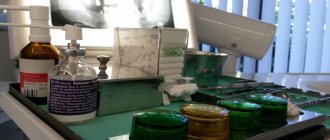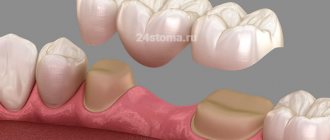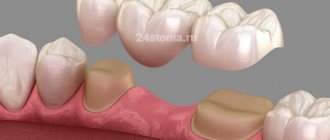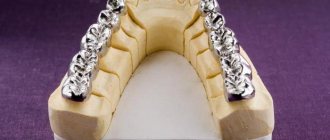Bridges - adhesive, ceramic, metal-ceramic, solid, install on implants and inlays at a competitive price.
It often happens that people lose teeth at a young age. Some become victims of bad genetics, others get into traffic accidents and receive serious injuries, others are exposed to infectious and inflammatory processes, etc. However, regardless of what reason led to the loss of teeth, this causes discomfort during communication and chewing food, and also leads to disturbances in the functioning of the gastrointestinal tract.
Fortunately, modern dentistry does not stand still, and prosthetics with bridges can solve the problem of the lack of several natural crowns in a row. Such structures are non-removable and are firmly attached to nearby teeth or implants. Also, today you can find dental bridges, for the installation of which metal/fiberglass beams or inlays are used.
If a bridge is placed on the original crowns, the number of missing units should not exceed 2 pieces. In case of loss of three or more teeth, it is advisable to use implants or resort to removable prosthetics.
The Elident clinic employs competent doctors who will not only professionally install a bridge, but also advise you on any questions regarding the installation of such dental structures. Having deep knowledge in the field of dental restoration, having impressive experience in the manufacture of various types of structures and perfect skills in working with modern materials, we are ready to guarantee reliable and long-term treatment results. That is, regardless of whether you need to install a metal-ceramic or ceramic bridge, all work will be carried out at a high level, in the shortest possible time and at affordable prices.
From this article you will learn what dental bridges are, you will be able to get acquainted with the algorithm for their installation and find out which types of such products are considered the best. In addition, we will talk about existing prices, describe some of the “cons” of these dental structures and provide information about the features of caring for them. These and other points will be discussed in this work.
Free consultation
Our specialists will conduct a free consultation and select the best treatment option for you.
Sign up now! Online registration
+7 (495) 649-41-19
Content
1 Indications for bridges and limitations for their use
2 Features of installing a fixed bridge 2.1 Method of grinding dental units for a future prosthesis
2.2 Preparation of supporting units for installation of prostheses
3 Bridges, before and after photos:
4 Which bridge structures should be preferred?
5 Solid structures
6 Metal-ceramic products: characteristic features
7 Ceramic fixed bridge: features 7.1 Some “cons” of zirconium bridges
8 What are the features of adhesive bridges?
9 Use of inlays for fastening dentures
10 Bridge prosthesis on implants
11 Basic rules of care
12 Price for a bridge
Indications for bridges and limitations for their use
As stated earlier, dental bridges can correct the defect associated with the deficiency of one or two missing units. Also, designs of this type are used in cases where the problem of the lack of natural crowns cannot be solved in any other way.
The processes that prohibit the use of bridge-like fixed dentures include:
- Incorrect location of dental units in the oral cavity;
- The presence of bruxism;
- Pathology in which there is intense loss of enamel;
- Diseases of the oral cavity in the acute phase;
- Osteoporosis;
- Acute inflammatory processes in the area of periodontal tissue;
- Inadequate oral care.
Since there are different types of bridges, differing in the method of fixation or the material used, you should first consult with your doctor regarding their choice.
We employ experienced and polite specialists who take into account both individual factors and the financial capabilities of each patient.
Bridge stamped and soldered
This method is considered the oldest and has been used since Soviet times. Made from a thin-walled sleeve shell. This occurs during the process of compressing a plaster copy of the tooth. At the joints they are soldered, which ensures a continuous connecting structure.
Disadvantages can be considered:
- the impossibility of creating an exact shape due to a loose fit,
- using this type of prosthetics, there is a high probability that caries will form in the future and this will lead to tooth loss,
- the walls turn out to be thin and, as a result, quickly wear off, which leads to destruction and breakage.
- Patients experience bleeding from the gums and an unpleasant metallic taste due to metal oxidation.
Features of installing a fixed bridge
The installation process of the above structure is as follows. The role of supporting elements is played by the teeth located on both sides of the lost unit. If there are no two natural crowns in a row in a row, then 3 units will act as supports (one on one side of the lost tooth, and two on the opposite side).
Regardless of whether the bridge will be fixed to the front teeth or installed on the chewing teeth, preparation of the supporting crowns is a prerequisite. Turning parameters may vary depending on the type of prosthesis being installed. If you plan to wear a metal-ceramic bridge, it is necessary to prepare the supports by 1.5 mm on the lateral part, and by 2-2.5 mm on the chewing side. If a ceramic bridge is installed, turning is carried out by 1 and 1.5 mm, respectively. It should be taken into account that the duration of the operational period is influenced by the preserved surface of the dental tissues located under the structure: the larger it is, the longer the service life of the bridge will be.
Method of grinding dental units for a future prosthesis
It should be noted that tooth preparation in close proximity to the gum tissue is carried out in such a way that a kind of ledge is formed on the stump. In turn, the ledge must be formed in such a way that the crown fits as closely as possible to the neck of the tooth. This will prevent infection from penetrating under the prosthesis, prevent the destruction of dental tissues and significantly extend the service life of the structure.
Attending doctors at the Elident clinic
Mlodik Boris Naumovich
Dental surgeon, implantologist, orthopedist
Clinical experience : 26 years
Vakhrushev Alexander Viktorovich
Dental surgeon, implantologist, orthopedist
Clinical experience : 25 years
Preparation of supporting units for installation of prostheses
In most cases, natural crowns, on which a permanent bridge will be fixed in the future, are subject to pulp removal. This is due to the high probability of injury to the neurovascular bundle during turning. However, when a metal-ceramic structure is put on, there is no need to remove the nerve in large dental units, since they have denser walls.
You can also keep your natural teeth alive if you install a ceramic bridge. The ability to preserve the nerve is considered necessary, since this has a positive effect on the strength and durability of natural units.
When it is planned to install a bridge, the cost of depulpation and subsequent filling is determined by the number of root canals, and can range from 2,500 to 5,000 rubles, respectively.
If, after the loss of a tooth, healthy, living crowns remain nearby, the possibility of grinding them down for a future bridge is considered undesirable. The same goes for nearby units that previously had small seals installed. In such situations, it is advisable to install one implant: its cost will cost you less than installing a bridge.
It is recommended to install a bridge in Moscow only when the teeth located on the border with the missing one were previously filled by 50% or were subjected to depulpation.
How many implants are needed to secure the prosthesis?
In case of complete absence of teeth, the minimum number of implants on which an orthopedic structure can be installed is 2 (all-on-2 protocol). True, this is only possible in the lower jaw, the bone of which is denser. The upper jaw bone is more porous, so fixation requires at least 4 implants (all-on-4). Installation of a minimum number of titanium “roots” is resorted to in cases where the patient’s budget is strictly limited.
However, if possible, it is better to install a larger number of titanium pins. The more there are, the more evenly the chewing load is distributed. Implant dentists believe that the ideal option is 1 implant for 2 missing teeth. In this case, the jawbone will receive sufficient stimulation to prevent its arthophia. If you use less, the atrophy will only slow down.
Which bridge structures are best?
When it is planned to fix a bridge prosthesis on the front teeth, its price leaves much to be desired, since we are talking, first of all, about aesthetics. To produce artificial teeth that replicate natural teeth in transparency and shade, it is necessary to use high-quality material – zirconium dioxide.
In addition, the specialist’s work is greatly complicated by situations caused by excessive exposure of the patient’s gums when smiling, as well as those associated with a significant degree of transparency of the enamel. In this case, the question of how much a bridge costs takes a back seat, since the primary goal is to achieve impeccable aesthetic characteristics.
However, if a bridge is placed over chewing teeth, then functionality becomes a priority.
Next, we will consider the following types of bridges:
- Metal-ceramic structures;
- Adhesive bridge prosthesis;
- Zirconium dioxide products;
- Solid-cast bridges.
Types of contraindications
Are common
These include pregnancy, acute diseases of the whole body or oral cavity, the stage of rehabilitation and recovery, drug addiction, the condition after radiation therapy, cancer, cachexia (extreme exhaustion of the body), drug therapy with certain drugs, mental illness, acute stress.
In all of the above states, the body is already in a stressful situation. We can say that the priority is to restore the functioning of all organs and systems, and the absence of teeth temporarily fades into the background.
When the situation is resolved or the patient enters the stage of remission (rest), we can talk about prosthetics.
Local
They are directly related to the condition of the dental system, as well as the type of proposed structure. There are several types of fixed dentures. There are contraindications that apply to all clinical situations . These include:
- Allergic reaction to the material from which the structure is made;
- Low level of oral hygiene;
- Inflammatory diseases of the oral mucosa;
- Inflammatory diseases of periodontal tissues;
- Diseases of the temporomandibular joint in the acute stage;
- Inflammatory diseases of the bone tissue of the jaws.
External interference is stressful for the body. Defense mechanisms easily deal with it. But in all the cases listed above, local immunity is reduced, therefore, there will not be a proper response. Prosthetics will only aggravate the situation . Therefore, it is advisable to resolve the condition, and only then begin restoring the dentition (in case of allergies, replacing the original material).
Next, we will consider a narrower range of contraindications for each type of fixed prosthesis.
Solid structures
Solid-cast bridges are a single structure made using injection molding technology. The creation of such a product is based on the use of cobalt-chrome alloy. Depending on the patient’s preferences, a cast bridge can be presented in the following options:
- Using gold-like plating;
- Without the use of “gold” plating;
- With plastic or ceramic coating.
An important feature of such bridge structures is their precise fit to the supporting crowns, which prevents the penetration of food debris and the appearance of deposits under them. Such products are characterized by increased strength and a long service life. Their service life can reach 10 years, without the need for significant preparation of the supporting units.
The production process of cast bridges is considered quite simple and does not require the use of innovative techniques, but the quality of the above structures is impressive.
The only drawback of such products is their low aesthetics, which allows them to be fixed only to dental units located in the chewing area.
Contraindications to veneer prosthetics
Veneers are very thin plates that are installed on the front (front) part of the tooth. They are made of composite material, ceramic or porcelain. Used in the so-called “smile zone”.
Straight bite
Normally, the upper teeth should overlap the lower teeth by ⅓. In the case of a straight bite, the upper and lower incisors are in contact with the cutting edges. In this case, it is not advisable to use veneers, since the likelihood of them chipping is high .
In the absence of chewing teeth
It would seem what this has to do with veneers, which are installed on the frontal group of teeth. But in the absence of chewing teeth, the front teeth experience a load several times higher than normal. The height of the bite also decreases. The likelihood of the veneer chipping will be quite high.
Thin layer of enamel
When installing veneers, a small layer of enamel is removed. Therefore, if there is a deficiency, tooth preparation will be difficult.
The presence of a filling of significant size
In this case, the strength of the tooth is already reduced.
Metal-ceramic products: characteristic features
A metal-ceramic bridge is a complex dental structure that includes a metal base and an outer ceramic layer. In this case, the prosthesis frame can be made of cobalt-nickel or cobalt-chrome alloy, and can also contain precious metals.
Currently, designs based on the use of gold alloys are especially in demand. This allows you to get the most natural shade of the crowns and use them to restore lost units in the frontal zone. In this case, the frame can have a thickness of approximately 0.5 mm.
Advantages of metal-ceramic prostheses:
- Allowed for use in the frontal zone;
- The metal bridge has a solid base, which contributes to the high reliability of the product and ensures a long service life;
- The ceramic layer is resistant to abrasion;
- Can be repaired if cracks or chips occur.
It should be remembered that before fixing a metal-ceramic bridge, the supporting crowns are subjected to pulp removal and turning.
Contraindications for inlay prosthetics
An inlay is a microprosthesis that restores the anatomical shape of a tooth. It can be restorative (when part of the crown of a natural tooth is preserved) and stump (used when the root is preserved, the coronal part is missing). They are made from metal, ceramic, composite and a combination of materials.
- Small carious cavities;
- Carious cavities in hard-to-reach places;
- Pathological mobility;
- Short tooth roots, thin walls;
- Obstruction of the tooth root canal.
Ceramic fixed bridge: features
As you know, a ceramic bridge is considered the most expensive: its price is determined by the use of a material characterized by ideal aesthetic qualities and increased strength. We are talking about zirconium dioxide.
At the same time, in the process of creating these structures, a milling machine with modern software is used. However, not the entire bridge is milled, but only the base, made of zirconium dioxide, which is subsequently lined with porcelain. Thanks to this technology, the aesthetic parameters of the structure are significantly improved.
Due to the extreme strength indicators (more than 900 MPa), a metal-free prosthesis can have any length, which is not possible when using other types of ceramics. The following is an algorithm for producing such bridges.
So, the process of manufacturing a metal-free structure includes the following steps:
- Initially, the doctor prepares the supporting crowns, which involves removing the nerves and further preparation in order to ensure the most precise fit of the prosthesis;
- Next, the product is reproduced in three-dimensional format, during which special software and the resulting scan of the jaw are used;
- The frame of the product is produced;
- After this, the frame made on the basis of a three-dimensional model is fired, which makes it possible to obtain the necessary characteristics of wear resistance and strength;
- Ceramic mass is applied to the base layer by layer;
- The structure is being painted.
Since zirconium material has the same light transmittance as natural enamel, bridges made from it perfectly recreate the lost units in the frontal zone.
In addition, ceramic products are distinguished by a tight fit to the supporting crowns, which prevents the penetration of infection under them. The ability to maintain a natural shine for a long time is also one of the “advantages” of metal-free dentures.
Some "cons" of zirconium bridges
When using ceramic bridges for prosthetics, the following disadvantages may occur:
- Overpriced;
- High risk of chipping. Despite the fact that zirconium material has extreme strength, the outer porcelain layer is quite fragile and there is an increased likelihood of chipping. According to statistics, such defects occur in approximately 10% of patients within 6 years from the date of installation of ceramic products;
- Some aesthetic inconsistency. If ordinary zirconium blocks are used, they have a milky tint and do not provide the translucency inherent in natural crowns. However, nowadays you can find more expensive and natural-looking zirconium material that allows you to achieve ideal aesthetics, for example, Katana® UTML (Japan) and Prettau® Anterior (Germany).
What are the features of adhesive bridges?
An adhesive bridge has a more gentle method of attachment to the supporting crowns. When using this design, there is no need for total preparation of the natural units necessary for its fixation.
Below we describe cases in which it is better to use an adhesive bridge:
- Minor defects in dental units located in the chewing and frontal zones;
- In the presence of inflammatory processes in the area of periodontal tissue;
- If standard methods of restoring teeth are unacceptable, due to a particular disease in the patient;
- Ideal for people who have had a heart attack;
- Patients who prefer a gentle method of prosthetics.
To fix the above bridge, only one visit to a specialist is required. If the bridge structure is planned to be made in a laboratory, you will have to visit the doctor again.
3 methods of fixing an adhesive prosthesis:
1. Using a composite adhesive
In this case, the specialist glues strips of fiberglass or plastic to the inner surface of the teeth. The main purpose of these elastic plates is to connect artificial crowns with natural ones. This method is not used for units located in the chewing zone;
2. Beam technique
To do this, small recesses are made in the supporting crowns, into which a special wire beam is subsequently attached. In this case, the priority option would be for the patient to have dental units with impressive fillings, which makes it possible to obtain ready-made recesses for the beam. But this method has one significant “minus” - an increased likelihood of pulpitis in the abutment crowns.
3. Splinting method
This method is based on the use of a special tape made of fiberglass material, for fixation of which the dentist drills a small cavity in the support units.
The advantages of such designs include:
- Possibility of instant removal of the bridge from the oral cavity if necessary;
- Good aesthetics, since the prosthesis does not contain any metal components;
- There is no need to remove the nerve;
- Easily repairable in case of fracture;
- It is possible to maintain some mobility of the supporting units, which is achieved due to the presence of an elastic composite material.
The use of inlays for attaching prostheses
To fix bridges, it is allowed to use special inlays made of ceramic or metal material. In this case, there is no need for total grinding of the supporting crowns: it is enough to make a small ledge on the chewing side of the dental unit.
The installation of such products is recommended only to reproduce 1 lost unit in the presence of healthy nearby crowns. In addition, due to the insufficient stability of structures on inlays, sometimes it is necessary to fix the crown at one edge.
Materials used
For the manufacture of solid-cast prostheses, gold (both in pure form and sputtering) and stainless metals, or rather their alloys, are used.
The materials used can be combined, and such a prosthesis will be classified as combined or with veneer. The following materials are used as the base material for the manufacture of a solid-cast bridge:
- gold;
- silver and palladium;
- cobalt and chromium.
Structures made of chromium and cobalt can be improved by manufacturing in their natural form, gold plating, or ceramic coating to resemble natural hard tissues of teeth.
Our clinics
Clinic "Elident" on Varshavskaya
Varshavskoe highway, 75, bldg. 1, Moscow 117556
- Varshavskaya (500 m, closed until 2021)
- Nakhimovsky Prospekt (1,300 m)
Mon-Sat : 09:00-21:00; Sun : 09:00-19:00.
Online registration
+7 (495) 649-41-19
Elident Clinic in Annino
Varshavskoe highway, 154, building 1, Moscow 117405
- Annino (500 m)
- Academician Yangelya (700 m)
Mon-Sat : 09:00-21:00; Sun : 09:00-19:00.
Online registration
+7 (495) 649-41-19
Bridge prosthesis on implants
A bridge on implants is considered one of the most durable and reliable products used in prosthetics. A prerequisite for its fixation is the implantation of implants.
The installation process of this bridge is also carried out in several stages. These include:
- Preparation period: the specialist directs the patient for appropriate laboratory tests, assesses the condition of his oral cavity, takes an x-ray, studies possible limitations for prosthetics, carries out the necessary therapeutic measures, selects the appropriate type of prosthesis;
- If necessary, osteoplasty surgery is performed;
- The implants are being implanted. Depending on the number of lost teeth and the length of the bridge, 2-4 support screws are used. As a rule, the process of implantation itself is carried out quickly, and the engraftment period can reach 4-6 months. During this period, the specialist installs a temporary plastic bridge;
- After completion of the above period, special connecting elements (abutments) are put on the supporting feints;
- Next, the dentist makes impressions, which are used as a basis for the further production of the bridge structure;
- At the final stage, the bridge is fixed using a special cement composition.
What to do if a dental bridge “collapses”?
A bridge, like crowns, like any other orthopedic structures, has a certain service life that cannot be ignored. Of course, modern technologies and materials used in dentistry extend the life of dentures, but do not cancel it! The vast majority of patients wear a bridge until it breaks.
To avoid this, you need to regularly visit the dentist, who will notice that the denture has begun to deteriorate and will inform you about it in a timely manner. Moreover, it is not so much the prosthesis itself that is subject to destruction as the material under the crowns, with which it is attached to the supporting teeth. Over time, the prosthesis may become unstuck and fall out. There is also a danger of developing secondary caries under the crowns.
In order to remove the bridge, the doctor uses a special ultrasonic device, which destroys and crumbles the cement between the crown and the tooth, after which the prosthesis can be removed painlessly. Usually the prosthesis is replaced with a new one, but in rare cases it is possible to reinstall the old structure.
If it happens that the bridge falls off, consult a doctor immediately, because teeth ground for crowns should not remain open, this can damage them and even lead to loss.
If the bridge has just begun to wobble, do not delay, make an appointment with the dentist. The reason may be the development of secondary caries, a violation of the technology when installing the prosthesis, or the destruction of the bonding composite.
If you experience any pain under the prosthesis, consult a doctor immediately!
Do not panic if cracks or chips appear on the surface of the enamel; in most cases, the bridge can be repaired directly in the oral cavity without removing the denture.
If you swallow a dental bridge or a fragment of it, consult a doctor immediately! The sharp edges of a broken prosthesis can cut or puncture mucous membranes and damage internal organs.
Basic rules of care
Careful care of the prosthesis is a guarantee of its long-term operation. At the same time, it is important to pay attention to hygiene: it is necessary to clean the bridge, as well as the places where it adjoins the supporting dental units, at least 1-2 times a day. This will avoid the accumulation of food debris in this area and the development of infectious processes.
Experts recommend using gentle products that do not contain solid particles to eliminate the possibility of damage to the prosthesis. Also an important condition for the durability of the product is regular visits to a specialist for preventive purposes.
Price for a bridge
When considering a bridge on implants or other supporting elements, the price can be determined based on the materials used, the mounting option, the length of the prosthesis and other factors. It should be taken into account that in the production of a bridge structure at least 3 artificial crowns are used, which is why the cost must be increased three or more times.
So, for example, if you need to install an adhesive bridge to restore one lost crown, get ready to pay from 13,000 rubles. In turn, the price of a solid cast product starts from 10,000 rubles, and the cost of a ceramic structure can reach 60-70,000 rubles.
| Service | Price, ₽. |
| Consultation with an orthopedist | for free |
| Orthopantomogram - panoramic image of teeth | 950 |
| Ceramic crown Dutseram plus (Germany) | 20 500 |
| Ceramic crown made of zirconium dioxide | 35 000 25 000 |
| Empress crown | 19 000 |
| Ceramic crown made of zirconium dioxide on an implant | 35 000 |
| Temporary plastic crown/wedge. | 2300/1500 |
| Taking an impression from alginate mass | 400 |
| Diagnostic plaster model | 400 |
| Taking a double impression | 800 |
| Cementing inlays and crowns using Fuji cement | 700 |
| Cementing inlays and crowns using Fuji+ cement | 800 |
| Temporary cementation of one crown | 400 |
| Removing one crown with stamped sawing | 500 |
| Removing one crown with sawing the cast | 1 000 |
| Removing one crown with sawing MK | 800 |
Article expert (author):











